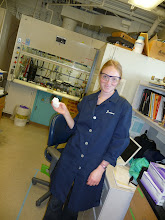 This phenomenon has to do with the materials used to create the images you see on your display, known as liquid crystals.
This phenomenon has to do with the materials used to create the images you see on your display, known as liquid crystals."Liquid crystal" refers to a material that exists in a state somewhere between a solid and a liquid, but closer to a liquid than a solid. A small amount of energy in the form of heat is required to turn a liquid crystal into a liquid, so they are quite sensitive to temperature, which makes them great for use in computer monitor displays, or even mood rings!
Liquid crystals come in two general varieties: thermotropic and lyotropic.
Thermotropic liquid crystals are further divided into isotropic or nematic varieties, which are distinguished by the arrangement of the molecules: isotropic liquid crystals are randomly arranged, while nematic liquid crystals are ordered in response to an external factor, such as a magnetic field, or an ordered surface. The ordering of the molecules is characterized by specific layering, or spiraling of the molecules.
But I still haven't explained how they work. Let's first think about the role of light (AKA electromagnetic radiation) in this process.
Recall from the last entry the discussion of "wave-particle duality," which referred to the dual nature of matter, which displays both wave-like and particle-like behavior. Light is no exception: light "particles" travel in a line and bounce off surfaces, but light also spreads out when passed through a narrow opening and interferes with light passing through another opening, much like a wave. Light is composed of energy in the form of electric and magnetic fields (hence the name "electromagnetic radiation"), which vibrate at right angles to each other. Since light's vibrations are aligned in two different planes, it is referred to as "polarized." The polarized nature of light not only allows us to protect our eyes by wearing sunglasses, but it is also the reason why you are able to see this computer screen presently!
A Liquid Crystal Display (LCD) requires two pieces of polarized glass sandwiching a sheet of liquid crystals (which, as we noted before, can be arranged in multiple, stacked layers) and aligned at a 90 degree angle. The direction of polarization (direction of the grooves) in the lower piece of glass will determine the arrangement of the bottom-most layer of liquid crystals, while the top piece of glass determines the arrangement of the top-most layer of liquid crystals, and all the layers in between will gradually spiral towards either groove direction, depending on their proximity to the top or bottom.
As light hits the first glass sheet, it is polarized in one direction and guided through the liquid crystals. The molecules change the light's plane of vibration so that it corresponds to their own angle (with respect to each successive layer of molecules) and when the light finally reaches the other sheet of glass, it is vibrating at the same angle as the last layer of liquid crystals, which is oriented to match the grooves in the second sheet of glass so that the light passes through.
But what if we don't want the light to pass through? We certainly could not change the display on our computer screen if the same amount and color of light was always able to pass through...
Another useful property of liquid crystals is that they can change their orientation in response to an applied electric charge. So if we want them to untwist, all we need to do is add in some energy (heat or light) and the liquid crystals will straighten, thereby changing the angle of the light passing through them so that it no longer matches the angle of the grooves in the top sheet of glass. In this case, light will not pass through that area and it will appear darker than the regions in which light does pass through!
Tune in next time to learn about the different types of liquid crystals used in LCDs and the ways we can use them to get different colors in our displays!





No comments:
Post a Comment